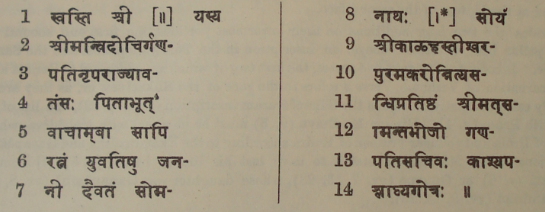|
The Indian Analyst
|
North Indian Inscriptions |
GANAPESVARAM INSCRIPTION OF GANAPATI. ......(L. 124.) For the merit of Gaṇapatidêva-Mahârâja, Jâyapa-Nâyaka granted (the following) shares (vṛitti) :— Three puṭṭi1 in Enumbaruta. Three puṭṭi in Pedda-Maddâli. Two puṭṭi in Kuru-Maddâli. Two puṭṭi in Ayanampûṇḍi. Two putti in Nentakoḍûru. Three puṭṭi in Prûnikoṇḍa. Two puṭṭi in Chîkulapalli. Two puṭṭi in Kauṇḍiparuta. Two puṭṭi in Pañchumbaruta. Two puṭṭi in Cheveṇḍru. Four puṭṭi in Donepûṇḍi. Two puṭṭi in Kâramûru. ......(L. 132.) In (the district of) Oḍapâṅgulu (he) granted (the following) land :— Two puṭṭi in Kautepalli. Two puṭṭi (in) Vreṅkaṭi. ......(L. 134.) For a perpectual lamp Jâyapa-Nâyaka granted twenty-five cows. POSTSCRIPT. ......I avail myself of this opportunity for correcting a mistake in my edition of the
Êkâmranâtha inscription of Gaṇapati. In line 11 of this inscription (Ind. Ant. Vol. XXI.
p. 201), write
TEXT.3
TRANSLATION. ........He whose father was the glorious minister Dôchi, the ornament of the kingdom of king Gaṇapati ; (whose) mother (was) Vâchâmbâ, the gem among women ; (and whose favourite) deity (was) Sômanâtha (Śiva),— that glorious Sâmanta-Bhôja, who belonged to the renowned gôtra of the Kâśyapas, the minister of king Gaṇapati, caused daily offerings to be established in the city of the blessed Kâḷahastîśvara.5 ......._______________________________ __________________________________________________________________________________________ ......1 According to Brown’s Telugu Dictionary, p. 623, the puṭṭi is the Indian ton-weight, equal to twenty tûmu
(marakkâl in Tamil). “The puṭṭi and its fractions also denote the extent of land that produces this quantity
of grain.”
| ||||||||||||||||||||||||||||||||||||||||||||||||||||||||||||||||||||||||||||
| > |
|
>
|








